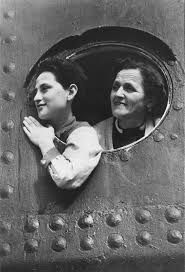REFUGEES FLEE FOR SAFETY
The world dealt with very similar concerns in the late 1930s, when the Nazi regime in Germany began systematically persecuting Jews and other minority groups. The Nazis, also called the Third Reich, were led by Adolf Hitler and believed the German race was superior to all others, and that other races and religions must be killed off. To escape direct threats against their lives, thousands of Jews began fleeing the country as refugees to find new homes.The MS St. Louis was one ship that transported Jewish refugees to safer countries. Piloted by Captain Gustav Schroder, the St. Louis set sail from Hamburg, Germany on May 13, 1939, carrying 937 passengers. Almost all the travelers were Jews escaping from the persecution they faced under Hitler's Third Reich. The ship was bound for Cuba, and then eventually for the United States.
The journey itself was very pleasant for the passengers, with fancy meals, activities for young people and some childcare, and religious services on Friday evenings. They enjoyed the trip very much, especially after facing so much stress and hardship in Germany.
AN UNPLEASANT WELCOME
What the passengers did not know about was unstableness of the political climate in Cuba. Shortly before the ship's departure, Cuba amended its immigration policies and retroactively invalidated the refugees' permission to come to the country. Right-wing Cuban newspapers cautioned the government against letting in the Jews, whom they believed would take away jobs from native Cubans who had been hit by the recent economic depression. Many also hated the Jews as an ethnic group - anti-Semitism was not exclusive to Nazi Germany in the 1930s.On May 27, the St. Louis weighed anchor in Havana, Cuba, where passengers were denied permission to leave the ship and officially enter Cuba. Soon 29 people were allowed to walk free, but the remaining 908 were confined to the ship, since their visas had not been finalized and the Cuban government refused to do so.
AMERICAN HESITATION
No one could convince Cuba to accept the refugees, so the St. Louis changed course and headed for the nearby United States. Even though U.S. newspapers had diligently reported the story of these passengers to the public, very few people saw any benefit in accepting the refugees. Secretary of State Cordell Hull advised President Roosevelt not to let them land.When some of the passengers contacted President Roosevelt directly and begged him to let them enter the country, he never responded to their plea. A telegram from the U.S. State Department told them they must "await their turns on the waiting list... for immigration visas."
The U.S. government and citizens had varying reasons for not making any special arrangements for the ship full of immigrants cruising up the coast. Immigration policy at the time set numerical quotas for how many people could come to the U.S. from various parts of the world. By mid-1939, the quota for Germany had already been met, and the waitlist extended for several years.
Additionally, U.S. citizens shared Cubans' concerns about new immigrants. The Great Depression left many Americans jobless, and many worried immigrants would compete for the few jobs that still existed. Anti-Semitism also ran deep in the United States. Americans sympathized with the plight of refugees on the St. Louis and other refugee ships, but 83% of citizens favored the strict immigration rules already in place. President Roosevelt and his administration saw no motivation to change these rules, so they refused to admit the Jews from the St. Louis.
EVENTUAL RELOCATION
Captain Schroder pressed on to find new homes for all of his passengers. Canada also declined to accept anyone from the ship. So Schroder sailed back to Europe, docking in Belgium, and worked deals with several countries on the continent. The United Kingdom, France, Belgium, and the Netherlands all welcomed hundreds of the refugees.Unfortunately, during the course of World War II, Nazi Germany invaded Belgium, France, and the Netherlands, so many of the previously safe refugees found themselves in danger all over again. Using survival statistics for Jews from these European countries during the war, scholars estimate that, ultimately, 709 of the passengers survived the war, and 227 did not.





